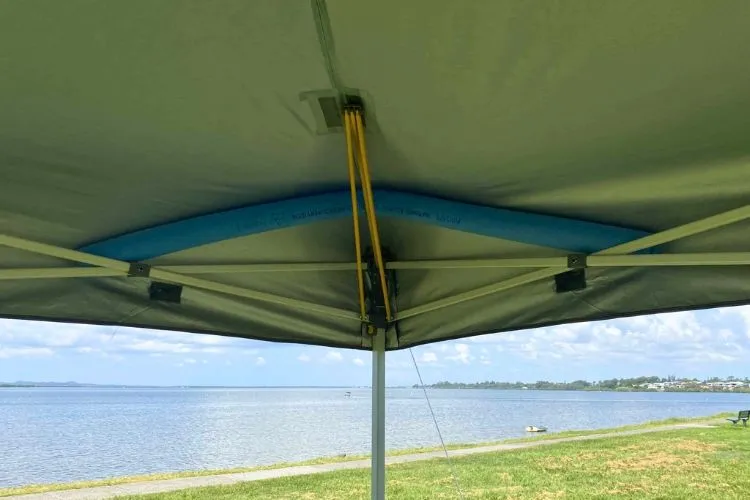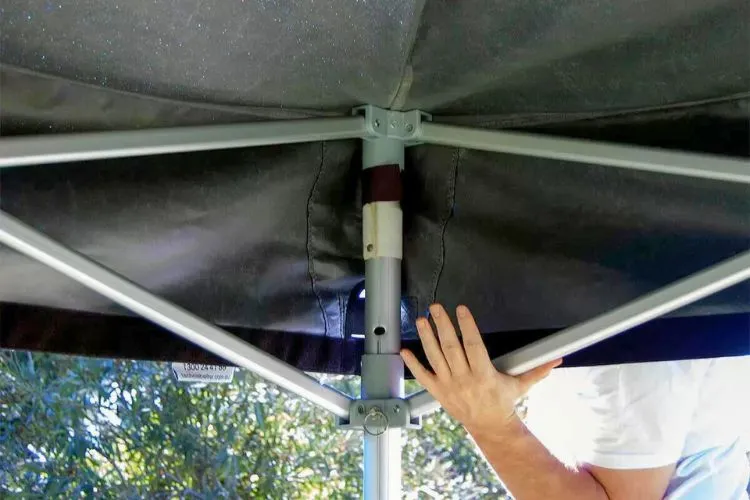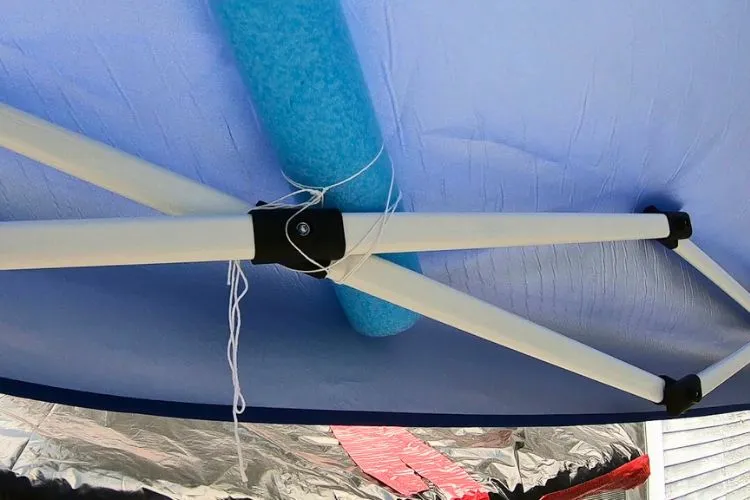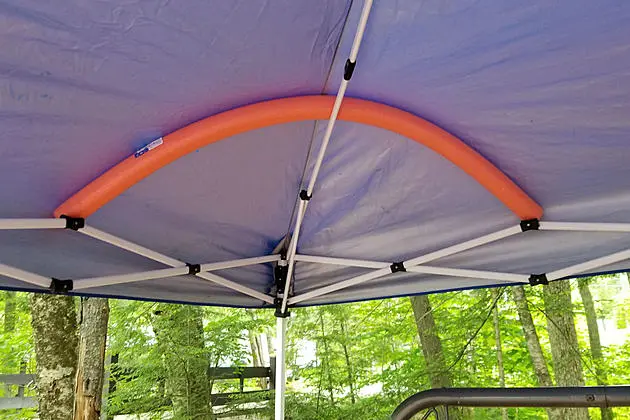A gazebo serves as a delightful retreat, a place of peace and joy, and an elegant addition to your garden landscape.
But when water starts to collect on the canopy, it can turn your serene escape into a source of worry and potential hazard.
Pooling water on the fabric of your gazebo can cause stretching, sagging, and in the worst cases, tearing.
This issue challenges the durability of the structure and lessens the canopy’s lifespan.
In this article, we will take a comprehensive look on how to keep water from pooling on your gazebo canopy and resolve this common problem.

Contents
- 1 Understanding the Causes of Water Pooling
- 2 How To Keep Water From Pooling On Your Gazebo Canopy?
- 3 Advanced Solutions
- 4 Troubleshooting Common Issues
- 5 Frequently Asked Questions (FAQs)
- 5.1 Should I be concerned about mildew or mold due to water pooling?
- 5.2 Can I waterproof an existing canopy that is not water-resistant?
- 5.3 Is it possible for water pooling to affect the structural integrity of my gazebo?
- 5.4 Will applying a water repellent treatment change the appearance of my gazebo canopy?
Understanding the Causes of Water Pooling
Before you can tackle the issue of water pooling, you need to comprehend why it happens. One primary reason is improper installation.
A gazebo that is not assembled on a level surface is susceptible to uneven water distribution, leading to pooling.
Therefore, checking the equilibrium of the gazebo base during installation is critical.

As time passes, the gazebo fabric can lose its initial tightness, leading to water gathering in the middle of the canopy. The reason is simple: water follows the path of least resistance.
If your gazebo canopy has any dips or low points, water will invariably find its way there. Thus, maintaining the tension of the canopy is central to guiding rainfall to run off as designed.
How To Keep Water From Pooling On Your Gazebo Canopy?
Routine Maintenance
Consistent maintenance is an excellent method to avert the accumulation of water on the canopy. Conduct regular checks of the structure, especially after heavy weather conditions.
Clearing any collected debris, such as fallen leaves or branches, ensures that water can freely move across the fabric and not collect in one place.
Canopy Supports
The framework on which the canopy fabric rests must adequately support the material. If the frame is too wide or does not have enough cross bars, the fabric can dip and hold water.
You may have to invest in additional supports or braces that will tension the fabric and prevent sagging.
Water Repellent Treatments
Waterproofing your gazebo canopy is another way to hinder water from pooling. Various treatments are available that can be sprayed or brushed on to create a water-resistant barrier on the fabric.
Using these products might require a bit of effort, but the prevention of pooling is worth the upkeep.
Proper Positioning
Consider the area where you place your gazebo. Selecting a spot that has good drainage and is not in the path of water runoff will help reduce the amount of water the canopy has to contend with.
Placement with respect to predominant wind directions can also aid in keeping the canopy dry.
Advanced Solutions
When the standard preventative measures are not enough, there are more advanced solutions you can employ. If you’re plagued with a persistent water pooling problem, consider the following:

Gazebo Rain Gutters
Implement a gutter system around the perimeter of your gazebo. This way, rainwater is caught and channeled away from the fabric surface before it even has the chance to pool.
Gutter systems can be found or fashioned to match the aesthetic of your gazebo, ensuring functionality does not compromise beauty.
Upgrading Canopy Material
If prevention has failed and repairs are becoming a regular occurrence, it may be time to upgrade your canopy fabric.
Heavier, more durable materials are less prone to stretching under the weight of water and can also withstand harsher weather conditions.
Though such materials may come at a higher cost, they are an investment in the longevity of your gazebo.
Troubleshooting Common Issues
While we always hope for the best, even with diligent care, canopies are not immune to the ravages of time, use, or extreme weather conditions.
Encountering minor tears is not uncommon, and addressing these issues promptly with a suitable repair kit can prevent them from worsening.

However, when facing more severe or ongoing problems, such as water pooling on a gazebo canopy, it becomes necessary to reevaluate the situation.
Persistent or significant structural concerns often indicate that a more in-depth professional assessment is warranted.
Opting for an expert’s analysis not only ensures safety but can also prove to be more economical in the long term, preventing further costly damage.
Frequently Asked Questions (FAQs)
Should I be concerned about mildew or mold due to water pooling?
Yes, sustained moisture on your canopy can lead to mold or mildew, which can compromise the material and pose a health risk.
Can I waterproof an existing canopy that is not water-resistant?
Yes, several products on the market can be applied to existing canopy fabrics to add a layer of water resistance.
Is it possible for water pooling to affect the structural integrity of my gazebo?
With time, the added weight of pooling water can strain the gazebo structure, leading to possible warping or breakage of the support frames.
Will applying a water repellent treatment change the appearance of my gazebo canopy?
Most water repellent treatments are designed to be invisible or to dry clear, so they should not significantly alter the appearance of your gazebo canopy.
Conclusion:
Your gazebo should stand as a place of solace, not of stress. Water pooling is an issue that, unchecked, can undermine this.
However, by understanding the causes and implementing proactive solutions, this common problem can be managed or entirely avoided.
Keep up with routine maintenance, and do not hesitate to invest in solutions that might cost more upfront but will save money and headaches in the future.
By regularly implementing these strategies and solutions, you can protect your gazebo from the damaging effects of water pooling.
Your gazebo is an investment for pleasurable outdoor experiences, and with proper care, it will serve as a beautiful, functional feature of your outdoor living space for years to come.

Sergio Gomes, a passionate advocate for outdoor living and the male voice behind Shades Authority. With years of experience, Sergio is your trusted source for expert insights on gazebos, pavilions, cabanas, pergolas, and all things outdoor shade solutions. Join him on a journey to transform your outdoor spaces into stunning, functional retreats
